Ambedkar Dukkipati
Semi-supervised Deep Transfer for Regression without Domain Alignment
Sep 05, 2025Abstract:Deep learning models deployed in real-world applications (e.g., medicine) face challenges because source models do not generalize well to domain-shifted target data. Many successful domain adaptation (DA) approaches require full access to source data. Yet, such requirements are unrealistic in scenarios where source data cannot be shared either because of privacy concerns or because it is too large and incurs prohibitive storage or computational costs. Moreover, resource constraints may limit the availability of labeled targets. We illustrate this challenge in a neuroscience setting where source data are unavailable, labeled target data are meager, and predictions involve continuous-valued outputs. We build upon Contradistinguisher (CUDA), an efficient framework that learns a shared model across the labeled source and unlabeled target samples, without intermediate representation alignment. Yet, CUDA was designed for unsupervised DA, with full access to source data, and for classification tasks. We develop CRAFT -- a Contradistinguisher-based Regularization Approach for Flexible Training -- for source-free (SF), semi-supervised transfer of pretrained models in regression tasks. We showcase the efficacy of CRAFT in two neuroscience settings: gaze prediction with electroencephalography (EEG) data and ``brain age'' prediction with structural MRI data. For both datasets, CRAFT yielded up to 9% improvement in root-mean-squared error (RMSE) over fine-tuned models when labeled training examples were scarce. Moreover, CRAFT leveraged unlabeled target data and outperformed four competing state-of-the-art source-free domain adaptation models by more than 3%. Lastly, we demonstrate the efficacy of CRAFT on two other real-world regression benchmarks. We propose CRAFT as an efficient approach for source-free, semi-supervised deep transfer for regression that is ubiquitous in biology and medicine.
Predictive AI with External Knowledge Infusion for Stocks
Apr 14, 2025Abstract:Fluctuations in stock prices are influenced by a complex interplay of factors that go beyond mere historical data. These factors, themselves influenced by external forces, encompass inter-stock dynamics, broader economic factors, various government policy decisions, outbreaks of wars, etc. Furthermore, all of these factors are dynamic and exhibit changes over time. In this paper, for the first time, we tackle the forecasting problem under external influence by proposing learning mechanisms that not only learn from historical trends but also incorporate external knowledge from temporal knowledge graphs. Since there are no such datasets or temporal knowledge graphs available, we study this problem with stock market data, and we construct comprehensive temporal knowledge graph datasets. In our proposed approach, we model relations on external temporal knowledge graphs as events of a Hawkes process on graphs. With extensive experiments, we show that learned dynamic representations effectively rank stocks based on returns across multiple holding periods, outperforming related baselines on relevant metrics.
Active Reinforcement Learning Strategies for Offline Policy Improvement
Dec 17, 2024Abstract:Learning agents that excel at sequential decision-making tasks must continuously resolve the problem of exploration and exploitation for optimal learning. However, such interactions with the environment online might be prohibitively expensive and may involve some constraints, such as a limited budget for agent-environment interactions and restricted exploration in certain regions of the state space. Examples include selecting candidates for medical trials and training agents in complex navigation environments. This problem necessitates the study of active reinforcement learning strategies that collect minimal additional experience trajectories by reusing existing offline data previously collected by some unknown behavior policy. In this work, we propose a representation-aware uncertainty-based active trajectory collection method that intelligently decides interaction strategies that consider the distribution of the existing offline data. With extensive experimentation, we demonstrate that our proposed method reduces additional online interaction with the environment by up to 75% over competitive baselines across various continuous control environments.
Interaction Event Forecasting in Multi-Relational Recursive HyperGraphs: A Temporal Point Process Approach
Apr 27, 2024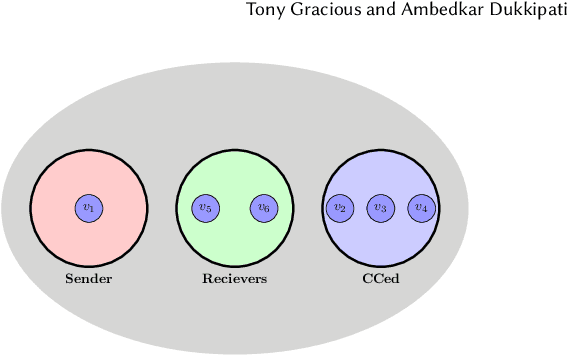



Abstract:Modeling the dynamics of interacting entities using an evolving graph is an essential problem in fields such as financial networks and e-commerce. Traditional approaches focus primarily on pairwise interactions, limiting their ability to capture the complexity of real-world interactions involving multiple entities and their intricate relationship structures. This work addresses the problem of forecasting higher-order interaction events in multi-relational recursive hypergraphs. This is done using a dynamic graph representation learning framework that can capture complex relationships involving multiple entities. The proposed model, \textit{Relational Recursive Hyperedge Temporal Point Process} (RRHyperTPP) uses an encoder that learns a dynamic node representation based on the historical interaction patterns and then a hyperedge link prediction based decoder to model the event's occurrence. These learned representations are then used for downstream tasks involving forecasting the type and time of interactions. The main challenge in learning from hyperedge events is that the number of possible hyperedges grows exponentially with the number of nodes in the network. This will make the computation of negative log-likelihood of the temporal point process expensive, as the calculation of survival function requires a summation over all possible hyperedges. In our work, we use noise contrastive estimation to learn the parameters of our model, and we have experimentally shown that our models perform better than previous state-of-the-art methods for interaction forecasting.
Deep Representation Learning for Prediction of Temporal Event Sets in the Continuous Time Domain
Sep 29, 2023
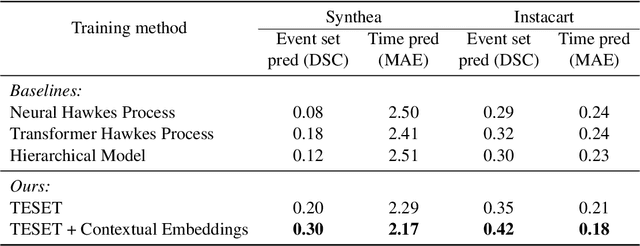
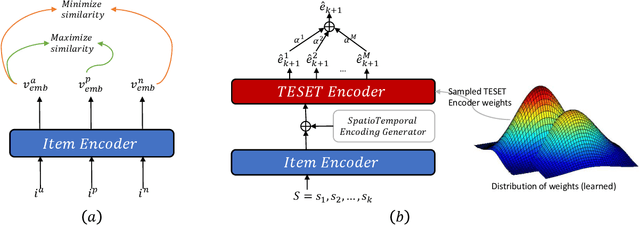
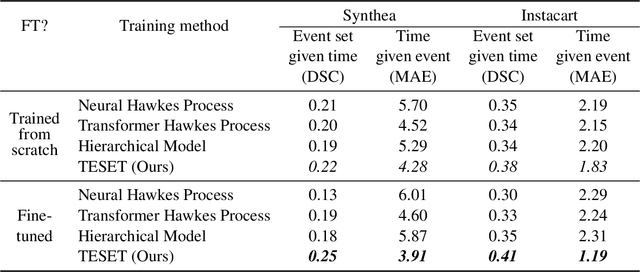
Abstract:Temporal Point Processes (TPP) play an important role in predicting or forecasting events. Although these problems have been studied extensively, predicting multiple simultaneously occurring events can be challenging. For instance, more often than not, a patient gets admitted to a hospital with multiple conditions at a time. Similarly people buy more than one stock and multiple news breaks out at the same time. Moreover, these events do not occur at discrete time intervals, and forecasting event sets in the continuous time domain remains an open problem. Naive approaches for extending the existing TPP models for solving this problem lead to dealing with an exponentially large number of events or ignoring set dependencies among events. In this work, we propose a scalable and efficient approach based on TPPs to solve this problem. Our proposed approach incorporates contextual event embeddings, temporal information, and domain features to model the temporal event sets. We demonstrate the effectiveness of our approach through extensive experiments on multiple datasets, showing that our model outperforms existing methods in terms of prediction metrics and computational efficiency. To the best of our knowledge, this is the first work that solves the problem of predicting event set intensities in the continuous time domain by using TPPs.
Markov Decision Process with an External Temporal Process
May 25, 2023

Abstract:Most reinforcement learning algorithms treat the context under which they operate as a stationary, isolated and undisturbed environment. However, in the real world, the environment is constantly changing due to a variety of external influences. To address this problem, we study Markov Decision Processes (MDP) under the influence of an external temporal process. We formalize this notion and discuss conditions under which the problem becomes tractable with suitable solutions. We propose a policy iteration algorithm to solve this problem and theoretically analyze its performance.
Neural Temporal Point Process for Forecasting Higher Order and Directional Interactions
Jan 28, 2023



Abstract:Real-world systems are made of interacting entities that evolve with time. Creating models that can forecast interactions by learning the dynamics of entities is an important problem in numerous fields. Earlier works used dynamic graph models to achieve this. However, real-world interactions are more complex than pairwise, as they involve more than two entities, and many of these higher-order interactions have directional components. Examples of these can be seen in communication networks such as email exchanges that involve a sender, and multiple recipients, citation networks, where authors draw upon the work of others, and so on. In this paper, we solve the problem of higher-order directed interaction forecasting by proposing a deep neural network-based model \textit{Directed HyperNode Temporal Point Process} for directed hyperedge event forecasting, as hyperedge provides native framework for modeling relationships among the variable number of nodes. Our proposed technique reduces the search space of possible candidate hyperedges by first forecasting the nodes at which events will be observed, based on which it generates candidate hyperedges. To demonstrate the efficiency of our model, we curated four datasets and conducted an extensive empirical study. We believe that this is the first work that solves the problem of forecasting higher-order directional interactions.
On consistency of constrained spectral clustering under representation-aware stochastic block model
Mar 03, 2022


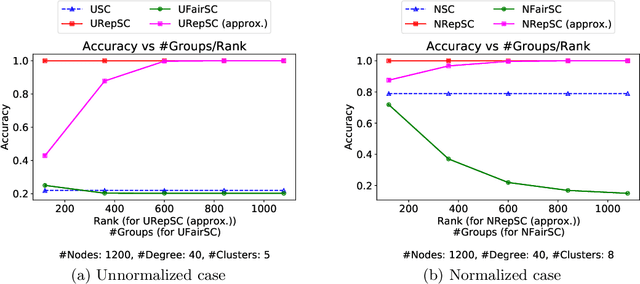
Abstract:Spectral clustering is widely used in practice due to its flexibility, computational efficiency, and well-understood theoretical performance guarantees. Recently, spectral clustering has been studied to find balanced clusters under population-level constraints. These constraints are specified by additional information available in the form of auxiliary categorical node attributes. In this paper, we consider a scenario where these attributes may not be observable, but manifest as latent features of an auxiliary graph. Motivated by this, we study constrained spectral clustering with the aim of finding balanced clusters in a given \textit{similarity graph} $\mathcal{G}$, such that each individual is adequately represented with respect to an auxiliary graph $\mathcal{R}$ (we refer to this as representation graph). We propose an individual-level balancing constraint that formalizes this idea. Our work leads to an interesting stochastic block model that not only plants the given partitions in $\mathcal{G}$ but also plants the auxiliary information encoded in the representation graph $\mathcal{R}$. We develop unnormalized and normalized variants of spectral clustering in this setting. These algorithms use $\mathcal{R}$ to find clusters in $\mathcal{G}$ that approximately satisfy the proposed constraint. We also establish the first statistical consistency result for constrained spectral clustering under individual-level constraints for graphs sampled from the above-mentioned variant of the stochastic block model. Our experimental results corroborate our theoretical findings.
An Inference Approach To Question Answering Over Knowledge Graphs
Dec 21, 2021
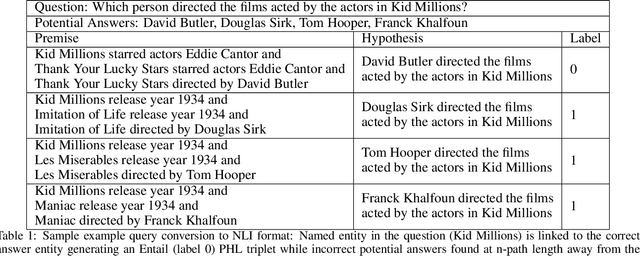
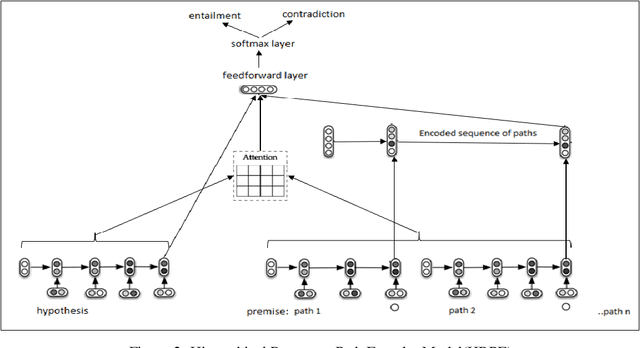
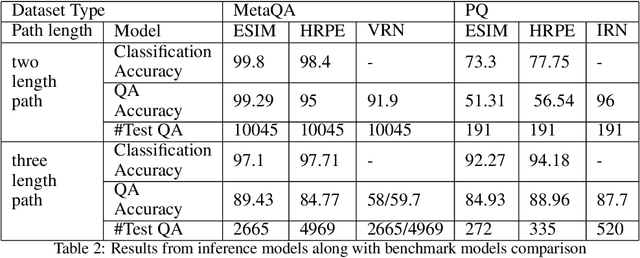
Abstract:Knowledge Graphs (KG) act as a great tool for holding distilled information from large natural language text corpora. The problem of natural language querying over knowledge graphs is essential for the human consumption of this information. This problem is typically addressed by converting the natural language query to a structured query and then firing the structured query on the KG. Direct answering models over knowledge graphs in literature are very few. The query conversion models and direct models both require specific training data pertaining to the domain of the knowledge graph. In this work, we convert the problem of natural language querying over knowledge graphs to an inference problem over premise-hypothesis pairs. Using trained deep learning models for the converted proxy inferencing problem, we provide the solution for the original natural language querying problem. Our method achieves over 90% accuracy on MetaQA dataset, beating the existing state-of-the-art. We also propose a model for inferencing called Hierarchical Recurrent Path Encoder(HRPE). The inferencing models can be fine-tuned to be used across domains with less training data. Our approach does not require large domain-specific training data for querying on new knowledge graphs from different domains.
Representation Learning for Dynamic Hyperedges
Dec 19, 2021
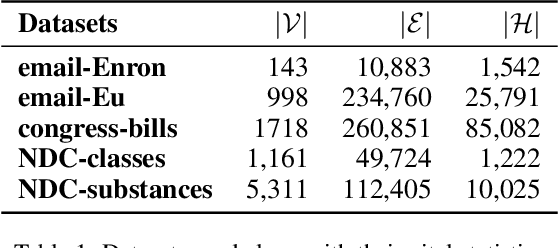

Abstract:Recently there has been a massive interest in extracting information from interaction data. Traditionally this is done by modeling it as pair-wise interaction at a particular time in a dynamic network. However, real-world interactions are seldom pair-wise; they can involve more than two nodes. In literature, these types of group interactions are modeled by hyperedges/hyperlinks. The existing works for hyperedge modeling focused only on static networks, and they cannot model the temporal evolution of nodes as they interact with other nodes. Also, they cannot answer temporal queries like which type of interaction will occur next and when the interaction will occur. To address these limitations, in this paper, we develop a temporal point process model for hyperlink prediction. Our proposed model uses dynamic representation techniques for nodes to model the evolution and uses this representation in a neural point process framework to make inferences. We evaluate our models on five real-world interaction data and show that our dynamic model has significant performance gain over the static model. Further, we also demonstrate the advantages of our technique over the pair-wise interaction modeling technique.
 Add to Chrome
Add to Chrome Add to Firefox
Add to Firefox Add to Edge
Add to Edge